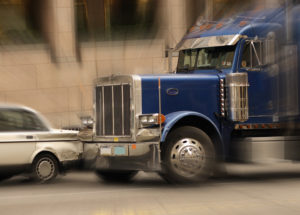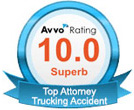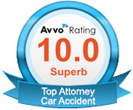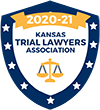
Did a Truck Rear End You?
Rear end truck accidents are probably the most common type of commercial truck crash. Federal data indicates that about 18% of large truck wrecks are rear end crashes. The typical rear end truck accident happens when the front of a big truck collides with the rear of a car or other vehicle ahead of it. Driving too fast, following too closely, not looking far enough ahead, driver inattention and distraction are all common causes or contributing factors.
While darkness increases the danger of truck crashes, surprisingly it is not a factor in most rear end truck crashes. Federal research indicates that more than 80% of rear end truck accidents happen in daylight. However, a fatal truck accident is more likely to happen in dark or low light conditions.
Crashes where the semi rear ends cars or other vehicles often occur where the vehicle ahead is moving. Highways, particularly conditions involving rush-hour or other heavy traffic are common scenarios. Federal data indicates that about 45% of crashes where the truck rear ends another vehicle happened on divided roadways. Highway rear end truck crashes often happen in heavy traffic, in icy, dangerous conditions and in darkness or low light at night.
Semi truck rear end accidents also often happen when a car or other vehicle ahead is stopped. Some examples are at an intersection for a stop sign, traffic signal or a left turn. These rear-end crashes often happen on local streets and roads. Research indicates that they represent about 10% of all large truck crashes. Driver inattention is likely the most common cause.
 Big trucks take more time and space than passenger vehicles to maneuver and stop. In perfect conditions it can take 290 feet, or about the length of a football field, for an 80,000 lb. semi traveling at 55 mph to come to a complete stop. Cars, being much lighter, can stop more quickly.
Big trucks take more time and space than passenger vehicles to maneuver and stop. In perfect conditions it can take 290 feet, or about the length of a football field, for an 80,000 lb. semi traveling at 55 mph to come to a complete stop. Cars, being much lighter, can stop more quickly.
One surprising fact about rear end truck crashes is that stopping an empty or lightly loaded semi truck takes more space and time than stopping one which is fully loaded. Due to the design of heavy truck springs and brakes stopping distance is longer if the truck has a light load or is empty. Therefore, truck drivers need to consider how fully loaded their truck is in making sure they are driving at a safe speed and have enough following distance.
Highway truck wrecks set up the potential for chain reaction crashes sometimes involving dozens of vehicles with the possibility for numerous injuries and deaths. Federal data indicates that more than more than 15% of crashes where the truck rear-ends another vehicle involve three or more vehicles. More than 1/2 of these crashes involve at least two trucks. Truckers following to close or driving too fast are frequent causes. Trucks traveling in groups or “convoys” may also be contributing factors.
Rear-end Truck Crash Causes include:
- Driver fatigue
- Driving too fast
- Driver inattention
- Distracted driving
- Following too close
- Bad weather conditions
- Lack of familiarity with route
- Drug or alcohol intoxication or use
- Inadequate driver skill/experience
- Defective brakes or other safety equipment
I Was Hurt In A Trucking Crash. Do I Have A Case?
If a large 18-wheeler smashed into your car, it’s automatically the truck driver’s fault, right? Not always. Truck accidents are often not that simple. You usually have to prove fault (usually on the part of the truck driver) in whole or part, to obtain economic and non-economic damages in truck accident personal injury cases. This might seem simple at first. It can become complicated fast.
Liability for a Rear-end Truck Crash
Truck accidents often are caused by a combination of factors. Determining liability can be complicated. Truck drivers are expected to maintain a safe following distance and anticipate hazards. Your Missouri 18 wheeler accident attorney may establish fault on the part of the trucker if, for example, he or she failed to allow enough room between his or her truck and the vehicle ahead, was speeding, driving too fast or was driving while distracted, for example, from a cell phone and did not notice that the vehicle ahead of them was slowing or stopping.
Under the law in some states rear-end accidents can be considered the fault of the driver of the striking vehicle. For example, Missouri law recognizes a “rear-end collision doctrine“. Under this rule if you are on a part of the road where you should be and a vehicle behind you rear ends you then generally, in the first instance, the driver who rear-ended you is considered to be at fault. Part of the reason for this rule is that the driver behind should have better view of what is ahead and should be better able to explain why the vehicle crashed than the driver of the vehicle which was rear-ended.
This rule is not absolute. In some situations, like when the driver behind has limited visibility, distance or time to react, it may not apply. Other states, like Kansas, do not recognize this rule. In those states it may take more to prove the fault of a trucker who rear-ends you.
In some cases law enforcement at the crash scene may give the truck driver a ticket for violations like following to close, driving too fast for conditions, inattentive driving or other violations. While laws and court ruling vary in different jurisdictions, the fact that the truck driver was cited may help establish their liability especially if they pled guilty to the violation charged.
Some people might think establishing fault when a truck rear-ends you is a “slam-dunk”. Our more than 20 years experience helping people injured in truck crashes shows that proving fault is not always a given. We have successfully handled cases where truck drivers, insurance companies and/or their attorneys have denied liability or tried to blame our client for rear-end truck crashes. We have seen them claim that our client pulled in front of the truck and slammed on the brakes or even that the truck didn’t have any contact with our client’s vehicle. So don’t assume that just because you were rear-ended by a truck that they are going to admit fault.
Why Is It Important for My Lawyer to be Experienced with Truck Accidents?
There are laws, regulations and insurance rules that apply differently between truck accidents and car accidents. Even evidence-gathering is different. Large commercial vehicles can weigh as much as 80,000 pounds. The potential for disaster is obvious. Further, truck companies and their insurers are often quick to dispatch response teams to the accident site, investigating and securing evidence. Without an experienced law firm who knows the workings of a truck case, you could lose valuable evidence (and time) for building your claim. The list goes on. If you’ve been injured in a truck collision, you’ll want an attorney who is knows how a truck wreck case works in the real world.
Truckers can help avoid rear-ending other vehicles by:
- Driving defensively
- Not driving when fatigued, sleepy or sick
- Following other vehicles at a safe distance
- Giving continuous attention to the road ahead
- Obeying speed limits and not driving to fast for conditions
- Not driving when weather or other conditions make it unsafe
- Following hours-of-service rules limits on driving and on-duty time
- Recognizing dangerous situations enough in advance to avoid them
- Making sure that the brakes and other safety equipment are working properly
Dangers of a Rear-end Truck Wrecks
Rear-end crashes involving large trucks can be catastrophic and are especially dangerous compared to rear end collisions involving smaller vehicles. A commercial truck can weigh 80,000 pounds or more. while the average passenger vehicle only weighs roughly 3,000 pounds. The discrepancy in size and weight can lead to severe and potentially deadly injuries. A truck is also more likely to cause wrecks involving more than one vehicle, most commonly known as a multi-car pileup or multi-vehicle collision.
Tractor-trailers and other heavy trucks also often carry hazardous materials (hazmat) which can be flammable, explosive, poisonous or otherwise dangerous. If, as a result of the crash cargo of this type is released, catches fire or explodes the danger can much more severe.
Rear end truck accidents can cause a wide range of injuries ranging from the relatively simple to catastrophic, gruesome and fatal. In the typical rear end injuries to muscles and ligaments in the neck and back (sometimes called whiplash or “soft tissue injuries”) are probably the most common kind of injury.
Depending on severity and other factors rear end truck accidents can cause wide range of other fatal or non-fatal injuries like brain injury, herniated discs, spinal cord injury, broken bones and damage to internal organs, among others. These can include catastrophic injuries like complete spinal cord injury potentially rendering the victim quadriplegic and severe brain injuries dramatically reducing mental functioning. The severity of these injuries is often increased in crashes involving 18 wheelers and other big trucks due to the truck’s weight and forces involved.
Compensation for Rear-End Truck Accident Injuries
Under Missouri and Kansas personal injury law for a surviving accident victims or the family of a fatally injured victim to recover compensation they must establish that another party like, for example, the truck driver and/or trucking company were at fault in some way. In certain cases, more than one company may be involved in a single accident claim, such as the trucking company, as well as the shipper of the goods.
In an truck accident, compensation your Kansas City 18 wheeler accident lawyer may pursue includes medical expenses, loss of income, property damage, and pain and suffering. So you may have a lot at stake. These cases can be complex. Large truck companies and/or their insurance carriers usually hire experienced and capable attorneys who are often willing to fight legal battles over truck accident damages in order to pay as little as possible. To properly protect your interests, it is important that you are represented by a skilled and experienced accident lawyer.
Flick Law Firm can review your truck accident case and help determine the best legal approach for you. We have been successfully representing clients in Missouri and Kansas for over two decades, and helping them get recoveries for accidents such as yours. Contact Flick Law Firm to schedule a consultation.
Last Reviewed and Edited by Lawrence Flick on Jan 14, 2022.










